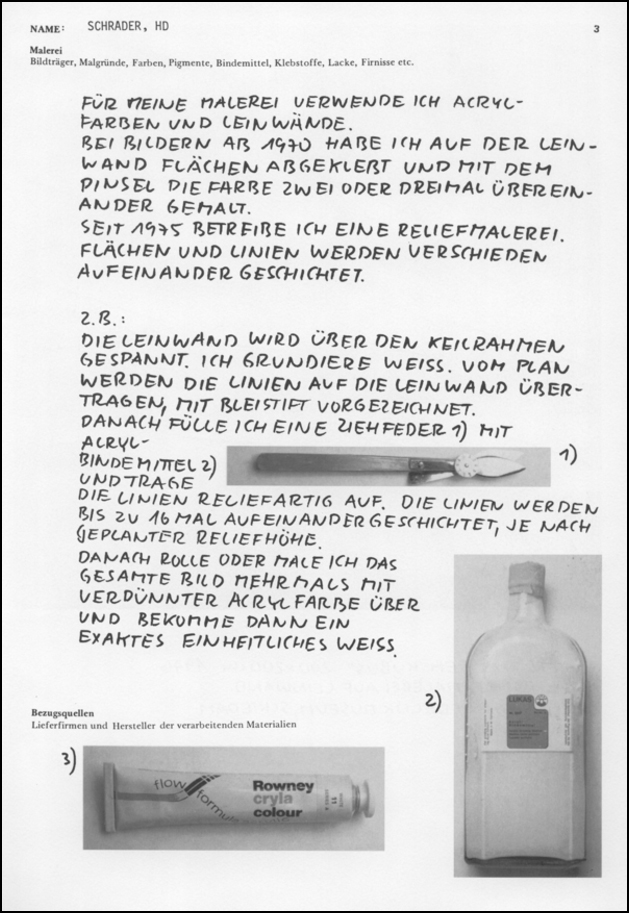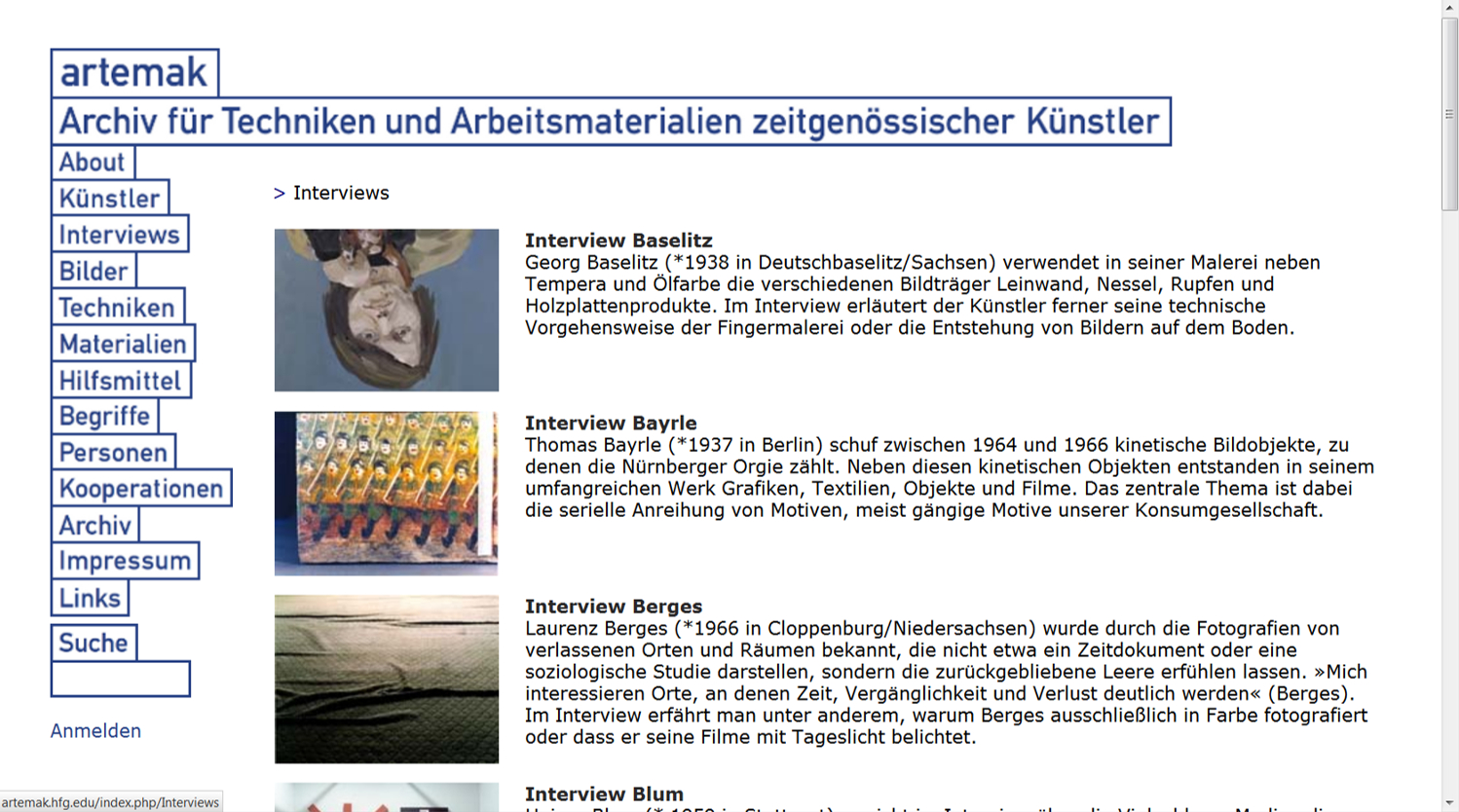History
Beginnings
The artist's survey as a scientific method emerged out of numerous initiatives, projects and networks, and has been developing steadily since the 1980s. When Erich Gantzert-Castrillo founded the Archiv für techniken und Arbeitsmaterialien zeitgenössischer Künstler (Archive for Techniques and Materials of Contemporary Artists) over 40 years ago, he was one of the first to establish a systematic survey of artists in the field of conservation.
During his time as a conservator at the Wiesbaden Museum, he recognised the importance of communicating with artists about the documentation and preservation of contemporary works of art:
“As a result of the conceptual shift in the art of the 20th century, the accompanying industrial development of new techniques and materials, and artists' great willingness to experiment, a whole new set of problems arose for the preservation and restoration of contemporary art, which demanded a new approach. I came to this realisation in the seventies, as a conservator at the Wiesbaden Museum. New materials – plastics or natural materials, for example – and new techniques called for unfamiliar treatment methods. Equally, new artistic concepts such as room installations with electronic equipment also required different kinds of management and care.
Based on this experience, I founded the "Archive for Techniques and Materials of Contemporary Artists" in 1972, with the aim of creating a foundation of collected facts to draw upon as new questions arise, and to do justice to the individual object in terms of preservation and restoration. In the course of initial conversations, I encountered great interest from artists, and they were willing to give me the information I wanted." [1]
In the 1970s, Gantzert-Castrillo conducted a large-scale survey and sent 320 questionnaires to artists in the German-speaking countries. [2] He developed four different questionnaires, focussing on painting, sculpture and object art, graphics, and art in architecture, which he used to gather information on materials and techniques, and to ascertain the involvement of craft businesses, workshops and delivery companies. The answers in the 138 returned questionnaires show great variety in terms of their form and level of detail, ranging from a few words to descriptions over several pages.
The archived material was published in book form in 1979 under the title Archiv für Techniken und Arbeitsmaterialien zeitgenössischer Künstler – Band 1 [3]. The handwritten and typed statements were printed as facsimiles and illustrated with images of the artworks. The book was sold out in a short time, as was the 1996 reprint [4]. A Digital Copy of the reprint (german version) is available via the following link: Archiv für Techniken und Arbeitsmaterialien zeitgenössischer Künstler – Band 1, Reprint 1996
These first questionnaires reflect the central issue in the emerging field of modern and contemporary art conservation, which is to learn more about materials and techniques in order to deal with the increasingly complex issues involved in preserving contemporary art. In addition to tangible information, the Gantzert-Castrillo questionnaires provide astonishing impressions of the artists' very different approaches to materials and technical questions, as well as their willingness to share this information.

Development of the archive
Since the 1970s, various new approaches and methods for preserving contemporary art have been developed and tested. The continuously expanding Archive [5] formed part of this development and Erich Gantzert-Castrillo also began interviewing artists to collate detailed, authentic statements:
"There was something impersonal about the questionnaires. I wasn't always comfortable with that. What I liked was the contact. The contact with the producer, the artist." [6]
The systematic compilation of relevant information, which began in the 1970s with the questionnaires, was later carried out largely on the basis of extensively documented interviews. The aim of the surveys was broadened to include characterisation of the artists' work – especially in terms of the intentions expressed with or transferred into particular materials and techniques. The interviews addressed the opinions of the artists on presentation concepts and the phenomena of ageing and damage, as well as their perspectives on preservation.
The approach of interviewing artists has since become an indispensable prerequisite for the documentation of materials, techniques and ageing phenomena, and especially for the development of preservation strategies for complex works of art.
At the conferences Modern Art: Who Cares? and Mortality Immortality? The Legacy of 20th-Century Art by the end of the 1990s, innovations in the preservation and restoration of contemporary art were particularly distinct. Gantzert-Castrillo presented the Archive for Techniques and Materials of Contemporary Artists there. [7]
A result of these developments was the creation of international expert networks with online platforms. Since then, the archiving and information exchange have taken place primarily online. A few projects made their interviews with artists freely accessible online as videos or transcripts, as did Erich Gantzert-Castrillo with the online platform artemak.de.

The archive in the 21st century
The online platform artemak.de was developed as a continuation of the Archive, beginning in 2005 and published in 2011 by the Institut für Digitales Gedächtnis (Institute for Digital Memory) at the Karlsruhe University of Arts and Design. Alongside the website's core content of artist interviews, it was possible to display and link to comprehensive imagery such as photos and videos, and to contextualise the information. The artemak website contained 17 interviews, around 400 images, over 500 glossary terms, the historical questionnaires from the artemak book and two research papers. [8] The website was forced to go offline in 2014 due to technical difficulties.
The idea of continuing artemak as a project at the Dresden University of Fine Arts (HfBK) developed out of conversations between Erich Gantzert-Castrillo and Ulrich Schießl, former rector and professor at the Dresden University of Fine Arts. In 2019, Gantzert-Castrillo handed over the artemak website and the physical archive to the University as a donation, in the hope that an institution would safeguard the work in the long term and continue the idea of artemak. The prelude to this was the research project artemak+X Techniken und Materialien der modernen und zeitgenössischen Kunst begun in 2018. With financing from the European Social Fund (ESF) and the state of Saxony, it was possible to redevelop the artemak website and adapt it to the requirements of a modern knowledge platform. The website was launched in 2021 and has since been operated by the Dresden University of Fine Arts.

Further information on the project history
Interview with Erich Gantzert-Castrillo (10/21/2019)
Artemak project description written by Erich Gantzert-Castrillo and Elisabeth Bushart (2011)
Notes:
[1] Translated Part of the excerpt from a project description by E. Gantzert-Castrillo and Elisabeth Bushart, published in 2011 on www.artemak.de.
[2] Gantzert-Castrillo first contacted artists whose art was presented in the collection of the Wiesbaden Museum. Other artists followed later, who were represented in public and private collections in Germany. See also: Gantzert-Castrillo, Erich. 1996. Archiv für Techniken und Arbeitsmaterialien zeitgenössischer Künstler – Band 1. Revised Reprint. Stuttgart: Ferdinand Enke Verlag: 11.
[3] Gantzert-Castrillo, Erich. 1979. Archiv für Techniken und Arbeitsmaterialien zeitgenössischer Künstler – Band 1. Wiesbaden: Harlekin Art/Museum Wiesbaden.
[4] Gantzert-Castrillo, Erich. 1996. Archiv für Techniken und Arbeitsmaterialien zeitgenössischer Künstler – Band 1. Revised Reprint. Stuttgart: Ferdinand Enke Verlag.
[5] At the time, Erich Gantzert-Castrillo was a conservator first at the Museum für Moderne Kunst Frankfurt and then at the Pinakothek der Moderne (Bayerische Staatsgemäldesammlungen München). Elisabeth Bushart, worked as a conservator on the Brandhorst collection (Bayerische Staatsgemäldesammlungen München) and supported him to continue the Archive.
[6] Interview with Erich Gantzert-Castrillo, conducted by Jonathan Debik and Sarah Giering, 21 October 2019, Dresden University of Fine Arts.
[7] Gantzert-Castrillo, Erich. 1999. “The Frankfurt Museum für Moderne Kunst and a Private Archive: Registration Systems for Contemporary Art”. In Modern Art: Who Cares?, ed. Hummelen, Ijsbrand and Sillé, Dionne. Amsterdam: Foundation for the Conservation of Modern Art/Netherlands Institute for Cultural Heritage/Archetype: 284-289.
Gantzert-Castrillo, Erich. 1999. “The Archive of Techniques and Working Materials used by Contemporary Artists”. In Mortality Immortality? The Legacy of 20th-Century Art, ed.Corzo, Miguel Angel. Los Angeles: The Getty Conservation Institute: 127-130.
[8] These research papers were completed at the Dresden University of Fine Arts and were supervised by, among others, Erich Gantzert-Castrillo, who holds an honorary professorship for the preservation of contemporary art there.